
From Cape Town to Victoria Falls
On this three week plus, active, expedition style tour, you will vist four of southern Africa’s most beautiful and exciting countries. An unsurpassed trip of a lifetime for adventurous travellers.

TOUR HIGHLIGHTS
- Wonderful Cape Town, nestled at the foot of Table Mountain
- The beautiful orange/red Namib desert with the world highest dunes
- Cultural experiences in Damaraland and along Namibias dramatic coastline
- Safari in game rich Etosha National Park, home to a very varied population of big game animals
- The outstanding Okavango-delta, where the clear river waters run into the sand
- Chobe National Park, where the many Elephants set the agenda
- The magnificent Victoria Falls, one of the world’s biggest waterfalls
This exciting, classic overland journey takes us from Cape Town in South Africa to Victoria Falls in Zimbabwe. There is an experienced guide on hand throughout the tour. The tour includes staying in lodges along the route. In a specialised safari vehicle, with room for 12 guests, this tour will take you through South Africa, Namibia, Botswana to Zimbabwe.
Safari tour packed with impressions
This is a route that explorers and adventurers have travelled for centuries. The route takes us through beautiful nature and impressive scenery: from the cosmopolitan city of Cape Town, through game reserves, national parks, empty expanses of desert and the Okavango-delta, all of which offer an unforgettable safari adventure.
Cape Town - a big city in a fantastic location
The tour starts in Cape Town, a captivating big city, in one of the world’s most beautiful locations - many visitors could imagine settling down here.
Sossusvleis high dunes and historical Swakopmund
You will visit Sossusvlei and experience the world’s highest sand dunes, together with Swakopmund, which is a historical and cultural reminder of the country’s German colonial past.
Fantastic Victoria Falls
The tour ends at the mighty Victoria Falls in Zimbabwe, an extraordinarily rich experience. The waterfalls are amongst the biggest in the world and one of the country’s most popular tourist attractions.
Safari vehicle with guide
If the tour is fully booked with 12 participants you will drive in a large 4x4 safari vehicle. The guide will make sure you all swap seats regularly, so the sun and wind is shared equally, as not everybody will have a window seat.
Itinerary
DAY 1: Departure from local airport
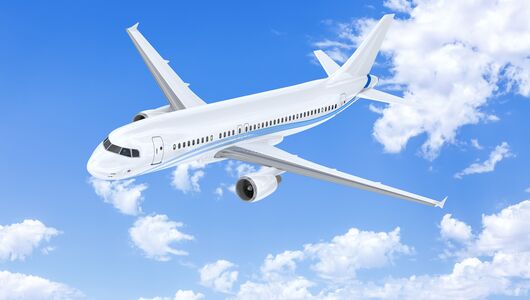
Fly to Cape Town, via Johannesburg.
DAY 2: ARRIVAL IN CAPE TOWN
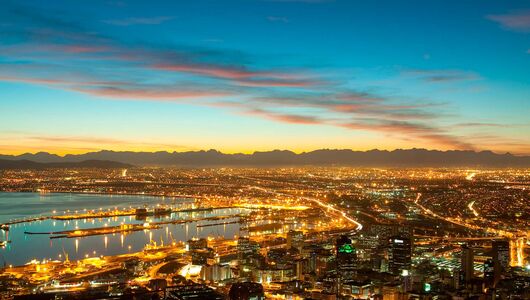
You will arrive in Cape Town early in the morning. A local representative of Safari Eksperten will meet you at the airport and drive you to The Townhouse Hotel, where you will spend the first three nights of your tour.
You are free for the rest of the day to explore Cape Town, before meeting your guide and the rest of the group in the hotel in the evening for a short information meeting about the tour.
Accommodation is in The Townhouse Hotel (or similar) and includes breakfast.
DAY 3: CAPE TOWN

This morning you will be collected and taken by cable car, up the legendary Table Mountain for spectacular views of the Mother City and the surrounding peninsula (weather dependent). Back to the city, you will see the Company Gardens, Greenmarket Square, the SA Museum and colourful and the picturesque Malay Quarter known as Bo-Kaap.
In the afternoon we suggest visiting the V & A Waterfront, situated in the heart of Cape Town’s working harbour, which offers abundant indoors shopping and entertainment.
Accommodation is in The Townhouse Hotel (or similar) and includes breakfast.
Distance travelled: 50 km
DAY 4: CAPE TOWN

Today we explore the Cape Peninsula. Travelling along the Atlantic Seaboard via Sea Point, Clifton and Camps Bay, we stop at Maiden Cove look-out point before continuing to Hout Bay. Here you have the option to take a boat trip to Seal Island (seasonal and not included in the cost). We carry on over Chapman’s Peak, one of the world’s most breath-taking coastal drives, to Cape Point and the Good Hope Nature Reserve. In the afternoon we travel on to Simon’s Town, a village with charming Victorian architecture, a naval base and a large penguin colony at the beautiful Boulders Beach. Kindly note the reserve entrance fee at Boulders Beach carries an additional cost.
Accommodation is in The Townhouse Hotel (or similar) and includes breakfast.
Distance travelled: 250 km
DAY 5 CAPE TOWN TO CEDARBERG MOUNTAINS
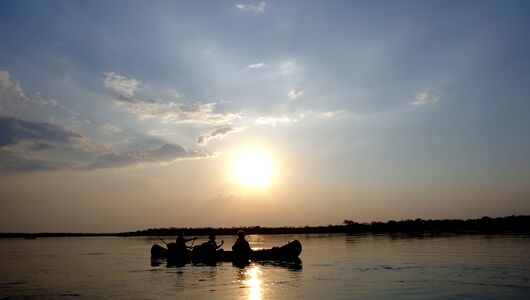
An early start takes us to the beach on the Atlantic Ocean to have a last look at Table Mountain across the bay. After lunch we head towards the Cedarberg Mountains, where we overnight in Clanwilliam, one of the ten oldest towns in the country that nestles at the feet of the Cedarberg Mountains.
Accommodation in Clanwilliam Lodge (or similar) with full board.
Distance travelled: circa. 230 km
DAY 6: CEDARBERG MOUNTAINS TO ORANGE RIVER

Travelling up the West Coast, we pass through some magnificent mountain ranges on our way to the Orange River. If you are travelling in the South African spring you will see the spectacular carpets of wild flowers in the famous Namaqualand region. Later in the afternoon we will reach the Orange River, the natural border between South Africa and Namibia.
Accommodation in Felix Unite Camp Provenance (or similar) with full board.
Distance travelled: circa. 470 km
DAY 7: ORANGE RIVER

Today the only travelling is done in a canoe. Put your feet up and relax as the currents take you downstream the Orange River.
Accommodation in Felix Unite Camp Provenance (or similar) with full board.
DAY 8: ORANGE RIVER - FISH RIVER CANYON

We leave Orange River and cross into Namibia. En route we stop at Ai-Ais, where water, rich in sulphates and fluorides and with a temperature of around 60°C, gushes forth from the hot springs. In the Nama language “Ai-Ais” means “burning water”.
We then proceed to our accommodation, which is situated close to the Fish River Canyon. Fish River Canyon is regarded as the second biggest canyon on earth, only surpassed by the Grand Canyon in the USA. The Fish River Canyon is 160km long, up to 27km wide and up to 550m deep.
In the evening we can take in another perfect African sunset with the magnificent views and scenery along the edge of the canyon.
Accommodation in Canyon Roadhouse (or similar) with full board.
Distance travelled: circa. 220 km.
DAY 9: FISH RIVER CANYON TO SOSSUSVLEI

Today we drive further inland through the Namib Naukluft National Park.
Accommodation in Agama River Camp (or similar) with breakfast and lunch included.
Distance travelled: circa. 600 km.
DAY 10: SOSSUSVLEI
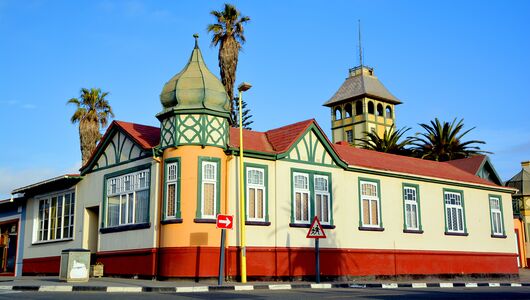
We depart early in the morning for an excursion to the world’s highest sand dunes around Sossusvlei and Deadvlei. Some of the most spectacular dunes are over 300m high. We will make a stop to see the view over Sesriem Canyon, which was carved into the landscape millions of years ago by the Tsauchab River
Accommodation in Agama River Camp (or similar) with full board.
Distance travelled: circa. 230 km.
DAY 11: NAMIB NAUKLUFT NATIONAL PARK TO SWAKOPMUND
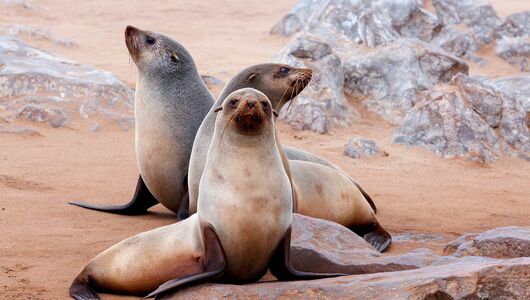
The day is spent driving in the Namib desert through the Namib Naukluft National Park on our way to Swakopmund. The Namib-Naukluft Desert is an ancient land with an ageless spirit. It is home to some of the rarest plant and animal species in the world.
After we arrive in the charming town of Swakopmund, an oasis set between the expanse of the desert and the Atlantic Ocean, we have the rest of the day free to explore this quaint little German town.
Accommodation in Hotel a La Mer (or similar) with breakfast and lunch included.
Distance travelled: circa. 295 km.
DAY 12: SWAKOPMUND & CAPE CROSS

In the morning we drive along the barren Atlantic coast from Swakopmund to visit the reserve at Cape Cross - the world’s largest breeding colony of Cape Fur Seals.
The afternoon is spent in Swakopund, where it will be possible to take part in some of the many activities available here. Otherwise you can simply spend the afternoon soaking up the atmosphere in town, visit a café, go shopping or take a walk along the beach - however the water is cold here, and the waves often rough, so swimming is only for the hardy!
Accommodation in Hotel a La Mer (or similar) with breakfast. Lunch and dinner are at your own expense today.
Distance travelled: circa. 250 km.
DAY 13: SWAKOPMUND TO ERONGO
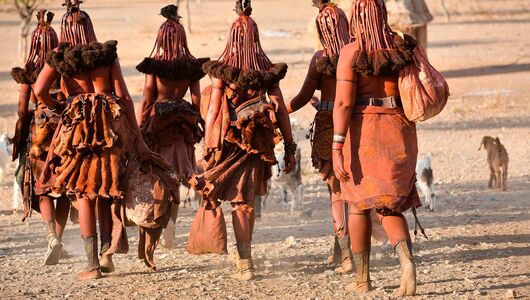
Leaving the cold Atlantic coastline behind us, we then head inland across the desert plains to the Erongo Mountains. We will stop at Ameib Farm close to Usakos to visit Philipp’s Cave. The cave is only fifteen meters deep, but is thirty five meters wide and seven meters high. The most famous cave painting is the “white elephant”, but there are also drawings of giraffes, rhinos, ostrich, springbok, kudus together with prints of human hands.
The afternoon can be used to further explore the area or simply for relaxing by the pool.
Accommodation in the Omaruru Guest House (or similar) with breakfast and lunch included.
Distance travelled: circa. 310 km.
DAY 14: KRISTALL KELLEREI, OMARURU & HIMBA VILLAGE
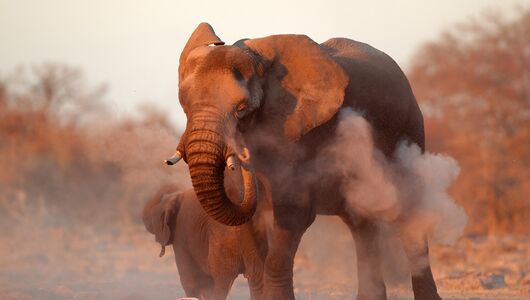
Today’s tour will take us to Kristall Kellerei, a small local distillery and vineyard, where we will have a guided tour. In the afternoon we will continue to Kamanjab, where we will visit a traditional Himba-village. This will be a journey of cultural exchange, learning and understanding the ways of the last traditional tribe in Namibia, the Ova-Himba.
Accommodation in the Oppi Koppi Restcamp (or similar) with ful board.
Distance travelled: circa. 330 km.
DAY 15: KAMANJAB TO ETOSHA

After our cultural experience in Kamanjab we will head to Etosha National Park, where the next three days will be spend on safari. In Etosha there is a good chance of seeing many of the biggest and most well known animals of the savannah. The nights will be spent next to illuminated waterholes, where many of the park’s nocturnal animals come to drink.
Accommodation in the Okaukuejo Camp (or similar) with full board.
Distance travelled: circa. 280 km.
DAY 16: ETOSHA NATIONAL PARK

Today offers a full day safari in Etosha. Etosha was made a National Park in 1907 and is home to approx. 114 species of mammal, 340 bird species, 110 reptiles and 16 amphibian species.
Accommodation in the Okaukuejo Camp (or similar) with half board. Dinner will be at your own expense.
Distance travelled: circa. 100 km.
DAY 17: ETOSHA NATIONAL PARK
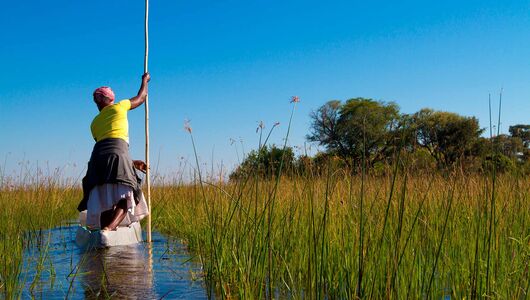
Another full day safari in Etosha where we will look for species such as cheetah, giraffe, zebra and antelope.
Accommodation in the Okaukuejo Camp (or similar) with half board. Dinner will be at your own expense.
Distance travelled: circa. 150 km.
DAY 18: ETOSHA TO KAVANGO RIVER

Our journey continues east as we drive along the Caprivi Strip to the town of Rundu. We make our way to Kaisosi River Lodge and spend a relaxing afternoon at our lodge on the banks of the Kavango River.
In the afternoon optional activities such as a visit to the Mbunza Living Museum, a traditional cultural school and local village for the local Kavango people, or a sunset cruise are available. It is also possible to unplug, relax by the pool, and enjoy the beautiful natural surroundings.
Accommodation in the Kaisosi River Lodge (or similar) with half board. Dinner will be at your own expense.
Distance travelled: circa. 435 km.
DAY 19: KAVANGO RIVER - OKAVANGO-DELTA
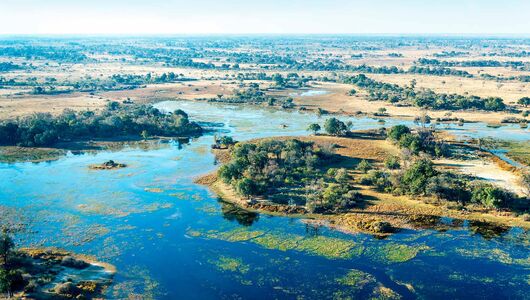
We leave Namibia and cross into the Okavango-Delta in Botswana, on its western border, and then head to camp.
Accommodation in the Guma Lagoon Camp (or similar) with full board.
Distance travelled: circa 380 km
DAY 20: OKAVANGO-DELTA

We will spend the day exploring the Okavango’s network of rivers, channels and lagoons in a mokoro (traditional dugout canoe), discovering a variety of birds and animals that live in this district.
We stop at a secluded island and take a one and a half hour guided walk, hoping to spot elephants, waterbuck and/or the other animals living in this water filled paradise.
Accommodation in the Guma Lagoon Camp (or similar) with full board.
DAY 21: OKAVANGO-DELTA TO CAPRIVI
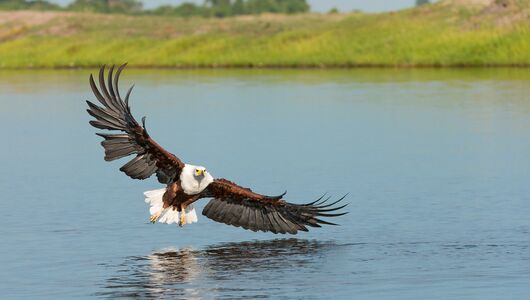
Leaving Botswana, we drive up the western border of the Okavango Delta before crossing back into Namibia and driving through the Caprivi-Strip.
Enroute to camp you will go on a game drive to the Mahangu National Park which is rich in fauna and flora. In the park you have the chance of spotting game such as sable and roan, elephants, hippos, buffalos, and many types of antelope. For bird watchers the Mahangu National Park offers more than 420 different bird species.
The tour will take us along the Caprivi-Strip, which is Namibia’s “access” to the Zambezi River. Our camp is on the banks of the Kwando River, and we will have the afternoon free to enjoy the activities available. It is a lovely place to relax under the shade of a tree, with a cool drink in hand, and enjoy the view over the river.
Accommodation in the Camp Kwando (or similar) in chalets with full board.
Distance travelled: circa 385 km
DAY 22: CAPRIVI TO CHOBE

Leaving Namibia we head along the Caprivi and cross the border back into Botswana to Kasane, the gateway to the Chobe National Park, which is the second largest national park in Botswana covering 10,566 km2.
After settling in to our lodge, you will have the remainder of the day at leisure or to partake in one of the optional activities.
Accommodation in the Chobe Safari Lodge (or similar) with full board.
Distance travelled: circa 265 km
DAY 23: CHOBE NATIONAL PARK

Today we rise early for a morning game drive in the Chobe National Park, which has one of the greatest concentrations of elephant found on the African continent. In the afternoon we go on a cruise on the Chobe River, a truly unforgettable experience and one of the best ways to view the wildlife and the spectacular sunset.
Accommodation in the Chobe Safari Lodge (or similar) with breakfast included.
Distance travelled: circa. 50 km
DAY 24: CHOBE TO VICTORIA FALLS
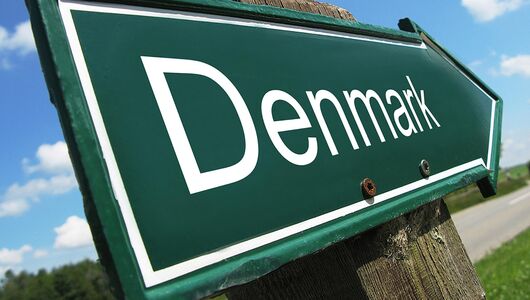
From Botswana we continue our trip to the Victoria Falls in Zimbabwe.
On arrival we will visit the magical Victoria Falls, which has the local name “Mosi oa Tunya” - “The smoke the thunders”
Accommodation in the A Zambezi River Lodge (or similar) with breakfast and lunch included.
Distance travelled: circa 90km
DAY 25: VICTORIA FALLS, ZIMBABWE
You will be collected from your hotel in the morning and driven to the airport to begin your journey home, via Johannesburg.
DAY 26: ARRIVAL HOME
Arrive back in Europe in the morning.
Accommodation on the tour

Hotel A La Mer
Hotel A La Mer lies in the heart of Swakopmund, only a few meters from the beach and a few meters from Swakopmund’s town center. All the rooms have a charming atmosphere, helping you to really feel at home. They all have an en-suite bathroom and toilet. On top of the wonderful beach, the hotel has its own bar and free WiFi. A good breakfast is served very morning, so you can start the day in the best way possible.
Read more
Camp Kwando
Uniquely situated on the banks of the Kwando River in Namibia, Camp Kwando is perfectly placed for you to explore Mudumu National Park. This camp sets great store in using as many local products as possible, such as food and drinks, solar energy and furniture.
Read more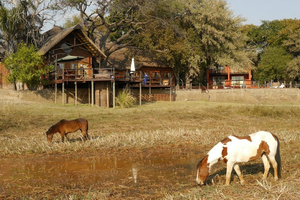
Kaisosi River Lodge
All the attractive rooms are nicely furnished and offer a bathroom, toilet and air-conditioning. The lodge also offers great meals that are served in the lodge’s own restaurant. If desired it is possible to enjoy your food out on the water. Kaisosi River Lodge also has a nice lounge and bar, where you can spend the evenings in a great atmosphere. Every evening the Kaisosi River Lodge invites you on a boat trip, so you can enjoy the beautiful sunset on the river. The camp’s swimming pool has a lovely location, so that you can have a really good view over the Okavango River.
Read moreA’Zambezi River Lodge
The hotel consists of thatched bedrooms that line the grounds in a majestic arch. All 83 rooms have en-suite bathroom, tea & coffee making facilities, direct-dial telephone and satellite TV and air conditioning. There are two restaurants and many fun-filled activities for you to enjoy including; table tennis, darts and boats for hire. Majority of the rooms have balconies facing the river and swimming pool whilst the rest face the National Park and the gardens.
Read more
Chobe Safari Lodge
Chobe Safari Lodge is located in Kasane on the banks of the Chobe River and bordering Chobe National Park. The lodge is close to the borders of 4 different African countries: Botswana, Namibia, Zimbabwe and Zambia. This make Chobe Safari Lodge unique and it is perfectly placed to visit some the famous nearby attractions such as Chobe, Victoria Falls or Caprivi.
Read moreAttractions on the tour

North Western Namibia
Along Namibia’s Atlantic coastline, starting at the border with Angola and stretching 500km to the south, lies the Skeleton Coast Park, which was created to protect the coastline and a desert than runs around 40km inland. The park gets its name from the many whale skeletons, and the close to 1,000 shipwrecks that can be found on the beaches. There are also a number of river deltas along the coast, which have a fine avifauna and can also be visited by antelopes and predators. Along the coast you can also find a number of large colonies of fur seals, but the largest of which with its 100,000 inhabitants, lies just south of the park, around 150km north of Swakopmund, in a small reserve created for them at Cape Cross. The seals are always very active in these colonies, the large males often taking part in violent confrontations with each other, as they seek to defend their small territories. Occasionally the colonies receive unwelcome guests, brown hyena, jackals and even lions sometimes come down to the beaches to raid the populations of fur seals.
Read more
THE BIG FIVE
The Big Five is a historic term that comes from big game hunting. It groups together the five animals that were considered to require the most courage and skill to hunt: Elephant, rhino, buffalo, lion and leopard. The term has been readily adopted by today’s wildlife safaris, on which rifles have been swapped for a camera and animals are only “shot” through a telephoto lens. It is also widely used in the marketing of reserves, camps and lodges, where the “Big Five” can be found, and visitors have a reasonable chance of encountering them.
Read more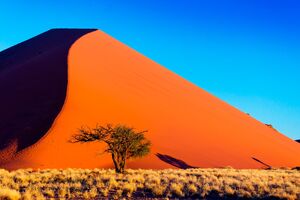
The Namib Desert
South western Namibia is totally dominated by the Namib Desert. The majority of the desert is under the protection of the Namib -Naukluft Park, which covers 6% of the whole country, some 50,000km2, which makes it the largest park in Africa and one of the very biggest national parks in the world. The most famous part of the park is the area close to Sesriem in its east, some 300km south of the capital Windhoek, and in particular Sossusvlei and Deadvlei, where there are a spectacular series of often dry flood plains.
Read more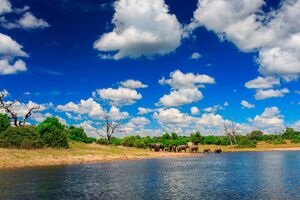
Chobe National Park
This national park offers a very varied wildlife experience, as broadly speaking, it covers two very different districts. The north of the park lies on the southern banks of one of the River Zambezi’s biggest tributaries, the Chobe River, on the gently sloping savannah, covered by many large trees, that run down to its waters. The river also forms the border with Namibia’s Caprivi province. In this section of the park elephants are undoubtedly the most dominant animal seen on a safari, whether it takes place in a car or on a boat in the river.
Read more
Victoria Falls
Victoria Falls is not only Zimbabwe’s biggest attraction, but also one of the whole most visited natural wonders. It is the biggest waterfall in Africa, and the second biggest in the world, and is simply so impressive that its dimensions are difficult to really comprehend: It is just over 1.7 km wide, it falls 108 meters at its highest point.
Read more




























